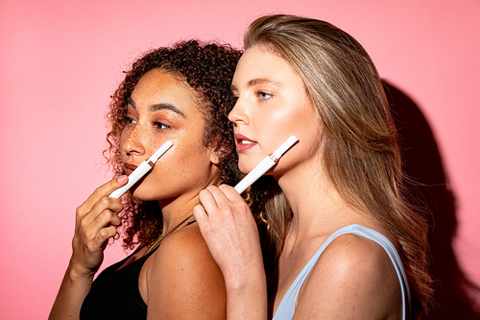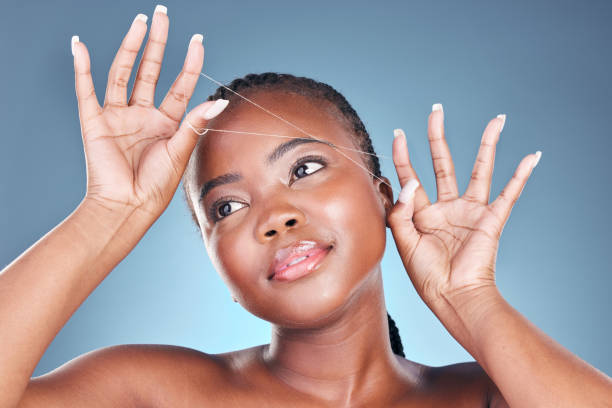Have you ever noticed a layer of light hair on your face that seems to be invisible to others? This hair is known as peach fuzz. It’s a type of facial hair that is usually very fine and soft, and it can be found on both men and women. While it may not be noticeable to others, some people may feel self-conscious about it. Although there is no harm in having peach fuzz on face, many individuals want to remove it for aesthetic reasons. Peach fuzz can be found on the cheeks, chin, upper lip, forehead, and other areas of the face. Most people have it, but it is more visible in certain lighting conditions.
If you have peach fuzz, keep reading to learn more about this issue and how you can remove it safely. But first, we will start with a brief overview of what causes peach fuzz on the face before moving on to the most effective treatments for it. Scroll down!
Causes Of Peach Fuzz On Face
Peach fuzz is a fine, soft hair that grows on the face and body. It is also known as vellus hair. Peach fuzz is perfectly normal to have, and it does not serve any specific purpose.
Peach fuzz is shorter and lighter in color than terminal hair, which is the thicker, longer hair that grows on the scalp and other areas of the body. Peach fuzz can grow on any part of the body, except the palms of the hands and the soles of the feet. It is most noticeable on the face, especially the upper lip, cheeks, and chin.
The amount of peach fuzz that a person has varies from person to person. Some people have very little peach fuzz, while others have more. Peach fuzz growth is also influenced by genetics, ethnicity, hormones, and age.
It appears on the face due to hormonal changes during puberty and pregnancy. Hormones such as estrogen and testosterone cause the hair to grow on different parts of the body, including the face.
In addition, genetics also play a role in how much vellus hair a person has on their face. Peach fuzz is more common in people with fair skin and light hair.
Furthermore, certain medications like birth control pills and steroids may also stimulate the development of facial peach fuzz.
is it ok to remove peach fuzz from face?
Yes, it is okay to remove peach fuzz from your face.
It is perfectly normal to have peach fuzz, and it does not serve any specific purpose. Some people may choose to remove peach fuzz for aesthetic reasons, while others may find that it helps to reduce the appearance of pores or fine lines. According to Dr. Michele Green, a board-certified dermatologist in New York City: “Removing peach fuzz can help to improve the appearance of the skin by making it look smoother and brighter. It can also help makeup to apply more evenly. However, it’s important to note that peach fuzz will grow back over time.”
You should be gentle and cautious while removing facial hair, as the skin on the face can be sensitive. Additionally, consider your skin type and any potential reactions to the chosen method. If you have concerns or skin conditions, consulting with a dermatologist or skincare professional is advisable to ensure the best approach for your specific needs..
If you choose to remove peach fuzz, it is best to use a clean, sharp blade or tool. You should also wash your face thoroughly before and after removing peach fuzz to help prevent infection.
How to remove Peach Fuzz On Face safely
If you’re uncomfortable with peach fuzz on your face, there are numerous treatments available for its removal. Here are some of the most popular options:
Shaving
Shaving is a quick and easy method to remove peach fuzz from the face. Using a razor can take off the fine hair on the surface of the skin without causing any damage. However, using a razor can sometimes irritate sensitive skin, so it’s important to shave carefully and use a good shaving cream or gel.
Waxing
Waxing is another popular method to remove peach fuzz on the face. It involves applying hot wax to the affected area and pulling the hair out in one motion. This method is usually done at a salon by a professional, but there are also home waxing kits available. However, waxing can be painful and may cause redness or irritation.
Threading
Threading is an ancient technique that involves using a thread to remove the hair from the root. The thread is twisted and rolled over the hair, which pulls it out. This method is precise and can remove even the finest hairs. However, it can be painful and time-consuming.
Depilatory creams
Depilatory creams dissolve the hair on the surface of the skin. They contain chemicals that dissolve the hair, making it easier to wipe away. These creams are easy to use and are readily available at drugstores. However, they can cause irritation and may not be suitable for all skin types.
Laser hair removal
Laser hair removal is a long-term solution to remove peach fuzz on the face. It involves using a laser to target the hair follicles and destroy them. This method is safe and effective, but it can be expensive and may require several sessions.
Plucking
Plucking is a more time-consuming method for removing peach fuzz, but it is also more precise. It is important to use clean tweezers and to pluck the hairs in the direction of growth.
Dermaplaning
Dermaplaning is a professional procedure that uses a blade to remove peach fuzz and dead skin cells. It is a relatively quick and painless procedure, and it can leave the skin looking smoother and brighter.
Prevention Of Peach Fuzz
There is no way to completely prevent peach fuzz from growing on the face. However, there are a few things you can do to reduce the appearance of peach fuzz and make it less noticeable:
Use sunscreen
Sun exposure can stimulate hair growth, so it’s important to protect your skin from the sun’s harmful rays. Use a broad-spectrum sunscreen with an SPF of at least 30 every day.
Exfoliate regularly
Exfoliating can help remove dead skin cells that can cause peach fuzz to become more noticeable. It also helps to promote cell turnover, which can prevent clogged pores and breakouts.
Avoid harsh chemicals
Harsh chemicals such as hair removal creams or acne medications can cause irritation and inflammation, making peach fuzz more noticeable. Opt for gentle skincare products that are free from fragrances and other irritants.
Eat a healthy diet
Eating a well-balanced diet that is rich in vitamins and nutrients can help promote healthy skin and hair. Foods such as salmon, avocado, and almonds are great sources of healthy fats and vitamins that can help improve the appearance of your skin.
Consider hormone therapy
If you have an underlying hormonal imbalance, hormone therapy may be recommended to help regulate your hormones and reduce the growth of peach fuzz on your face.
tips for caring for your face if you have peach fuzz
- Avoid touching your face throughout the day: Touching your face can transfer dirt and oil to your skin, which can clog pores and make peach fuzz more noticeable.
- Getting enough sleep is essential for good skin health. Aim for 7-8 hours of sleep per night.
- Keeping your skin hydrated can help minimize the appearance of peach fuzz and prevent irritation.
- Exfoliating too often can cause dryness or irritation. Stick to once or twice a week, and
- Remember that having peach fuzz on your face is completely normal and nothing to be ashamed of. If you’re comfortable with it, embrace it and don’t feel pressured to remove it.
FAQs
- Does shaving make hair grow back thicker? No, shaving does not make hair grow back thicker. It may appear thicker because the hair has been cut at a blunt angle, but it will eventually grow back to its original thickness.
- Is laser hair removal painful? Laser hair removal can be uncomfortable, but the level of pain varies depending on the individual’s pain tolerance and the area being treated.
- Can hormone therapy completely get rid of peach fuzz? Hormone therapy can help regulate hormonal imbalances that may be causing excess hair growth, but it may not completely get rid of peach fuzz.
- Can natural remedies like turmeric or honey remove peach fuzz? There is limited research on the effectiveness of natural remedies for removing peach fuzz. While some people have reported success with them, more research is needed to confirm their effectiveness.
- Can men get peach fuzz on their faces? Yes, peach fuzz can occur on both men and women’s faces.
Final Takeaway
Peach fuzz on the face is a natural occurrence that many people have. While it’s not harmful, some people may feel self-conscious about it. Luckily, there are various methods available for its removal. It’s important to choose a method that works for you and to care for your skin afterwards to prevent irritation. Remember that havingpeach fuzz on your face is completely normal and nothing to be ashamed of. Embrace your natural beauty and don’t feel pressured to remove it if you’re comfortable with it.




